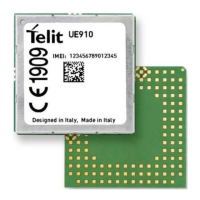Reproduction forbidden without Telit Communications S.p.A. written authorization - All Rights Reserved page 44 of 93
80 MHz in WCDMA Band VIII
> 33dBm(2 W) peak power in GSM
> 24dBm Average power in WCDMA
≤ 10:1 (limit to avoid permanent damage)
≤ 2:1 (limit to fulfil all regulatory requirements)
ANTENNA REQUIREMENTS (UE910-NAR and UE910-NAD)
Depending by frequency band(s) provided by the network operator, the
customer shall use the most suitable antenna for that/those band(s)
> 33dBm(2 W) peak power in GSM
> 24dBm Average power in WCDMA
≤ 10:1 (limit to avoid permanent damage)
≤ 2:1 (limit to fulfil all regulatory requirements)
ANTENNA REQUIREMENTS (UE910-GL)
Depending by frequency band(s) provided by the network operator, the
customer shall use the most suitable antenna for that/those band(s)
70 MHz in GSM850
170 MHz in DCS 1800
140 MHz PCS 1900 band
250 MHz in WCDMA Band I; 140 MHz in WCDMA Band II
460 MHz in WCDMA Band IV; 70 MHz in WCDMA Band V
80 MHz in WCDMA Band VIII
> 33dBm(2 W) peak power in GSM
> 24dBm Average power in WCDMA
≤ 10:1 (limit to avoid permanent damage)
≤ 2:1 (limit to fulfil all regulatory requirements)
When using the UE910, since there's no antenna connector on the module, the antenna must
be connected to the UE910 antenna pad (K1) by means of a transmission line implemented
on the PCB.
In the case the antenna is not directly connected at the antenna pad of the UE910, then a PCB
line is needed in order to connect with it or with its connector.

